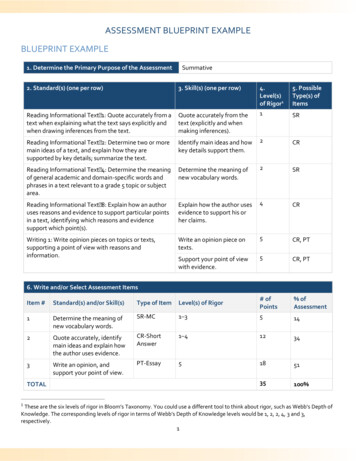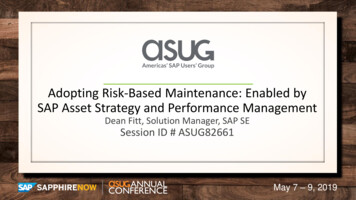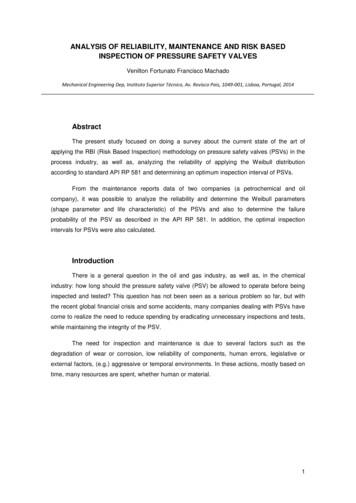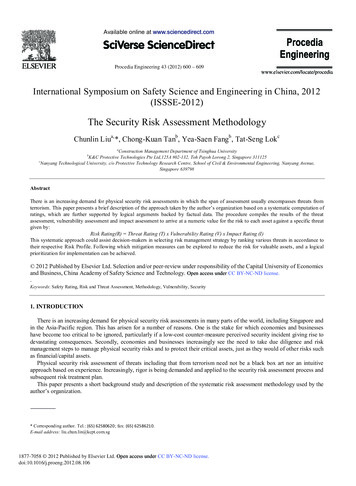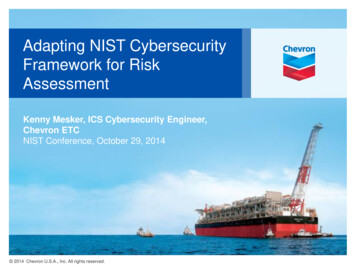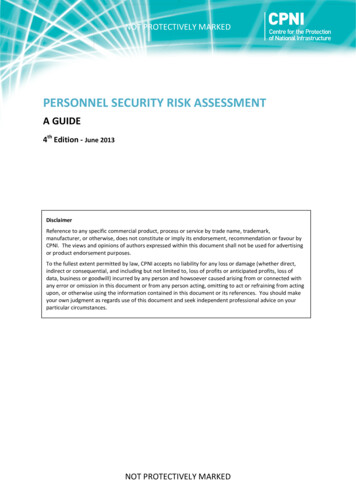
Transcription
Example risk assessment for maintenance work in a factoryThis engineering company manufacture parts for the motor industry – they employ 40 people on a site built in the 1970s.The managing director told themaintenance manager (the fitter) to do a risk assessment for maintenance work.The fitter works in a small workshop but also visits all parts of the factory. Their job includes selecting contractors and overseeing their work.How was the risk assessment done?The fitter followed the advice at www.hse.gov.uk/simple-health-safety/risk/. To identify the hazards and risks, they: looked at HSE’s web pages for the engineering industry and the publication Using contractors: A brief guide;walked around all the areas where they and contractors may go, noting things that might pose a risk;talked to the safety representative, supervisors and workers to learn from their detailed knowledge;looked at the accident book to get information on past problems.The fitter noted what was already being done to control the risks and recorded any further actions required. They discussed the findings with the safetyrepresentative, supervisors and the managing director, pinned a copy of the findings on a noticeboard and put them into practice.The fitter will review the risk assessment whenever there are any significant changes such as new work equipment, work activities or workers.Do not just copy this example and put your company name to it as that would not satisfy the law and would not protect your employees. You mustthink about the specific hazards and controls your business needs.The HSE site has a template and other examples to help you produce your own assessment.
Risk assessmentCompany name: ABC Engineering LtdAssessment carried out by: JB Singh(Maintenance manager)Date assessment carried out: 1 September 2019What are thehazards?Who might beharmed andhow?What are you already doing tocontrol the risks?What further action doyou need to take tocontrol the risks?Who needs to When is thecarry out the actionaction?needed by?DoneUnfamiliarity withthe site and/oruncertaintyabout the jobContractors maysuffer injuries or illhealth if notfamiliar withhazards such asasbestos ormachinery, or ifunsure of best wayto do a job. Most of the contractors have beento the site before (mostly on ‘repeatjobs’ such as machinerymaintenance, window cleaning etc)and are familiar with the layout, thesignificant risks, and how to controlthose risks. Fitter always works with companysecretary and supervisor to:o decide the best time forcontractors to be on site;o allow time for staff to knowcontractors will be on site/what job they’ll be doing. One-off jobs discussed with fitterand supervisor of area affected,and key issues agreed before workstarts, such as safe systems ofwork (control of flammables etc),who will supply necessary kit (egaccess equipment), and anynecessary personal protectiveequipment.Share this assessmentwith regular contractors.Check their awareness ofhealth and safety andmake sure they providestaff new to the site withhealth and safetyinformation.Fitter30/9/1930/9/19Use contractor’sawareness of health andsafety as key factor whenselecting them.Fitter (indiscussion withmanagingdirector)9/10/198/10/19Brief new contractors onhealth and safetyarrangements.Fitter9/10/198/10/19
What are thehazards?Slips and tripsWho might beharmed andhow?Fitter andcontractors maysuffer injuries ifthey slip onspillages, or tripover objects, andfall.What are you already doing tocontrol the risks?What further action doyou need to take tocontrol the risks?Who needs to When is thecarry out the actionaction?needed by?Done Contractors comply with companysign-in and sign-out procedures, sostaff know who is on site and wherethey are. Works manager does randomchecks on contractors on site toensure they are working safely.Instruct supervisors tochallenge contractors andinform fitter and seniormanagers if they areworking in an unsafe way.Managingdirector8/10/19 Generally good housekeeping (egprocedures for oil spillages in placeand adhered to). Floors generally in good condition. Good lighting throughout. Pallets etc stored in designatedarea. Staff wear safety shoes with a goodgrip.No further action requiredfor now.9/10/19
What are thehazards?Who might beharmed andhow?WorkplacetransportFitter and Good pedestrian/vehiclecontractors maysegregation measures on site, egsuffer very seriousseparate door for pedestrians toinjuries, such asfactory, marked walkways, railingsfractures andwere considered necessary,internal damage, ifreversing policy for deliveries etc.they are struck by All staff working outside, includinga vehicle such as acontractors, wear hi-viz tabard.lorry or a lift truck. Contractors know that they mustnot drive any company vehicles,including lift trucks. Annual lift truck safety inspections.Moving heavyobjectsFitter/contractorsmay be seriouslyinjured if struck byfalling heavyobjects during, forexample, themovement ofheavy plant ormachinery.What are you already doing tocontrol the risks? All staff involved in moving heavyplant or machinery to get togetherbeforehand to agree how the job isto be done safely, and the fitter (orsupervisor, if the fitter is absent)makes sure that everyoneunderstands what they should andshould not do. Fitter trained to drive a lift truck. Fitter, and three other staffmembers, trained in safe slinging. Trained person always in charge ofany lifting operation.What further action doyou need to take tocontrol the risks?Who needs to When is thecarry out the actionaction?needed by?DoneMake sure contractor hasa copy of companytransport safety rulesbefore job begins.Fitter6/10/19510/19Reception staff to remindcontractors of rules whenthey sign in.Reception staffFrom now onOne-day lifting andslinging course to bearranged to get otherstrained.Fitter9/10/199/10/19
What are thehazards?Who might beharmed andhow?What are you already doing tocontrol the risks?What further action doyou need to take tocontrol the risks?Sharpening toolsFitter and othersnearby may sufferserious impactinjuries if abrasivewheel fracturesduring use. Fitter trained to mount and useabrasive wheels safely, and hasmany years’ experience sharpeningtools. Only trained staff allowed tochange or use abrasive wheels.No further action at thisstage.Working atheightFitter andcontractors maysuffer severe,possibly fatal,injuries if they fallfrom any height,eg duringmachinery or LEVrepair. All contractor jobs involving work atheight discussed by fitter,contractor and other relevant staffand a safe system of work agreedbefore job begins. Access equipment (eg ladders,tower scaffold) kept in fitter’sworkshop and inspected before useand stored safely after use. Fitter trained to use ladders andtower scaffold safely.Read free HSE guidanceon work at height to checkthat all necessarymeasures are being taken.Manual handlingFitter andcontractors maysuffer back pain orpain elsewherefrom handlingheavy and/or bulkyobjects. Manual handling aids available – lifttruck, porters’ trolley, wheelbarrowetc. Fitter trained in safe manualhandling. Contractors told to ensure theirstaff follow safe manual handlingtechniques. For jobs involving difficult manualhandling, eg some machineryrepairs, fitter, contractor andrelevant others discuss beforehandand agree a safe system of work.No further action at thisstage.NoiseFitter/contractorsmay suffer If possible, jobs in production areasdone when the presses are not inNo further action at thisWho needs to When is thecarry out the actionaction?needed by?DoneFitter7/10/107/10/10
What are thehazards?ElectricityWho might beharmed andhow?What are you already doing tocontrol the risks?What further action doyou need to take tocontrol the risks?discomfort andpotential hearingdamage if workingin noisy areas orusing noisyequipment (egangle grinders).use. Fitter has ear defenders and knowshow to use them effectively andmaintain them properly. Contractors instructed to wearsuitable hearing protection whenthe job exposes them to loud noise. Maintenance machinery, eg drills,angle grinders, maintained toensure they run as quietly as ispossible.stage.Fitter/contractorsmay suffer shockand burns injuriesfrom faultyelectricalequipment orinstallation. Fitter, contractors and relevantothers discuss electrical safetybefore each job to ensure relevantmachinery, circuits etc are isolatedand locked off throughout the job. Contractors told to inspect allelectrical appliances pre-use andnot to bring any equipment on sitewhere condition of cables, switchesetc give rise to concern. Electrical installation and allequipment (including machinery infitter’s workshop) is inspected to aplanned schedule.No further action at thisstage.Who needs to When is thecarry out the actionaction?needed by?Done
What are thehazards?Who might beharmed andhow?What are you already doing tocontrol the risks?What further action doyou need to take tocontrol the risks?MachineryFitter and others All dangerous parts of machinerymay suffer seriousguarded to manufacturers’injury fromstandards.unguarded moving Machinery guards inspected everyparts of machinery.month and maintained in goodcondition. All new machinery checked beforefirst use to ensure they have theCE standard mark, a ‘Declaration ofConformity’ and there are noobvious accessible dangerousmoving parts, or location does notcause hazards, eg feed tables,take-off bins etc. Fitter (who is trained to set toolsand do daily checks of power pressguards) checks that setters on theshopfloor do daily checks of powerpress guards.Confined spacesFitter/contractorsmay suffer serious,possibly fatal,injuries if trappedin a confinedspace. No confined space working unlessthe job can’t otherwise be done (egthe degreasing plant is cleaned bythe fitter from the outside, usinglong-handled tools, so avoidingentry to the plant). All jobs, whether done by fitter orcontractor, that involve confinedspace working are risk assessedbeforehand and the necessarycontrol measures put in place, eg atleast two-person working, rescueplan agreed etc.Read free HSE guidanceon work in confinedspaces to check thatcurrent control measuresare sufficient and makesure contractors doing thistype of work are aware ofthe guidance.AsbestosFitter, contractors Building surveyed for asbestos andNo further action at thisWho needs to When is thecarry out the actionaction?needed by?DoneFitter710/19No further action at thisstage.8/10/19
What are thehazards?FireWho might beharmed andhow?What are you already doing tocontrol the risks?What further action doyou need to take tocontrol the risks?and others may beexposed toasbestos fibres,risking seriouslung disease, iffibres released (egthroughmaintenance work)into air andinhaled.asbestos-containing materials(ACMs) found in insulating boards.As these were in good conditionand in places unlikely to bedamaged or disturbed, they wereleft in place. Insulating boards clearly marked‘Danger, asbestos, do not disturb’and ‘Report any accidental damageimmediately’. Fitter checks condition of insulatingboards every 2 months.stage.Staff trapped couldsuffer fatal injuryfrom smokeinhalation/ Fire risk assessment done as atwww.communities.gov.uk/fire andnecessary action taken. Contractors told of fire andevacuation policy before working.No further action at thisstage.Published by the Health and Safety Executive 11/19Who needs to When is thecarry out the actionaction?needed by?Done
health if not familiar with hazards such as asbestos or machinery, or if unsure of best way to do a job. Most of the contractors have been to the site before ( mostly on ‘repeat jobs’such as machinery maintenance, window cleaning etc) and are familiar with the
